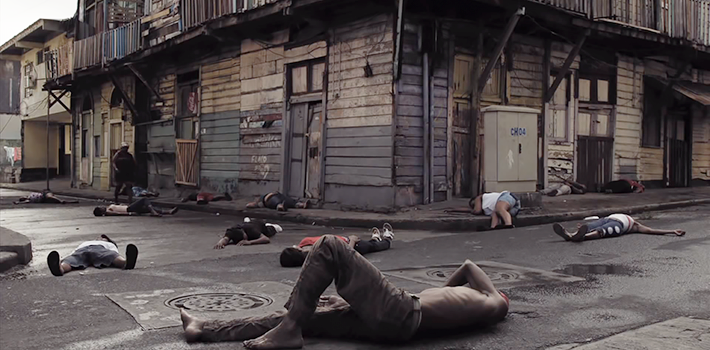
EspañolOne week ago, Invasion debuted in Panama’s cinemas, and the 90-minute documentary has revived memories of a monumental event for the Americas: the US military offensive against Panama that began in the early hours of December 20, 1989.
On that day, 27,000 US soldiers took control of Panama City, under the banner of “Operation Just Cause.” President George H. W. Bush was at the helm, as he sought to capture dictator Manuel Antonio Noriega and put an end to his rule. What could have been a confined abduction, however, turned into what local observers describe as a cruel massacre, one that has gone without restitution.
Invasion is not a documentary that seeks the “correct” version of events, nor does it bow down to either side of the story. Rather, Panamanian director Abner Benaim, presents something more meaningful and worth paying attention to: how Panamanians lived through that period, and what sentiments they carry in their hearts to this day.
“If you go to the street to film the invasion — well, it’s not there. No trace of it remains. The entire story is found in the memories of the people,” Benaim told Ibermedia, an outlet that promotes Latin-American films.
The documentary, therefore, draws heavily on reenactments to present the timeline of events. The voices and memories of those who were there, now participating in the film, help the viewer connect the dots of the story.
Local celebrities such as Roberto “hands of stone” Durán and Rubén Blades share their stories, along with the common people of affected communities. That includes El Chorrillo, a slum that was essentially destroyed, on account of alleged inaccuracies with US bombing of the area.
Throughout distinct settings in present-day Panama City, various eye witnesses act out the scenes of the invasion — full of death, fire, and destruction — as they remain etched in their minds. They seek to recreate images, as they explain to the camera how they lived them.
The Story behind the Silence
“The pain was not spoken of. It was so shameful,” singer and politician Rubén Blades tells Benaim in the film.
The many scenes make clear to viewers that, amid the pain and trauma, Panamanian society has yet to digest the event, much less move on from it. Those who tell the story do so with sadness, that no official record of the deaths exists (estimates range from 300 to 4,000); nor is there any state commemoration for the victims. Dispute also remains over the prudence of the invasion, as passers-by on the streets affirm, and whether to give attention to the terror that is now history.
Those who tell the story do so with sadness, that no official record of the deaths exists … nor is there any state commemoration for the victims.
“Many believed that if they were to seek justice or simply dignity for the dead, they could be confused with partisans for the regime of the drug-trafficker Noriega,” Benaim says of the silence, a chief theme. “Thus, they kept quiet. And others, those who populated El Chorrillo, the poorest in the city, took the catastrophe as another catastrophe in the long list they suffer from simply on account of their poverty. Thus, they also resigned to keep quiet.”
Such an aversion also appears in the documentary through the ambivalence of the younger generation of today. They lack a critical understanding of what happened and its significance for Panamanian democracy, in part because the implications are not even present in the nation’s educational curricula (as affirmed in one of the testimonies).
The Imperative to Speak Out
In the absence of formal documentation, Benaim seeks to salvage the history on the same streets where it took place, before the memories fade away.
Invasión begins with the bombs, then the fires, the reactions of Noriega’s loyalists, the impact on the families, the looting, and the siege of the dictator; finally, his surrender in the Apostolic Nunciature (the Vatican’s diplomatic mission).
The narrative also gives voice to the unequal impact on those who lived through the historic period. Some mourned the deaths or injuries of loved ones in El Chorrillo. Others, a block away, shared of a happy Christmas on account of expensive goods and a succulent dinner, looted during the mayhem. Meanwhile, in a wealthier neighborhood, a family offered a special dinner to a young US soldier, to show their appreciation for his participation in the intervention against the dictator.
Invasion shows the silent mourning — important for those who want to understand a little more of Panamanian society, and pay it the respect it deserves.
Invasion shows the silent mourning — important for those who want to understand a little more of Panamanian society, and pay it the respect it deserves.
Now, 25 years on, the continent is living through a new confrontation, between 21st-century socialism and the United States — a bipolar standoff that many thought ended with the Cold War. We also suffer from a modernized form of totalitarian dictatorship.
For this reason, the pain of December 20, 1989 — also understood as the outcome of a bloody dictatorship — should not be ignored by the world, and much less by the inhabitants of Panama and the region. Regardless of one’s political orientation, no plan for human coexistence can permit the proliferation of victims that result from barbarism at the top.
Invasion, with final production in Argentina, received the awards for best Central American or Caribbean film and best documentary at Panama’s International Film Festival this past April. From September 25, it has been showing in theaters across the nation, and you can follow @InvasionDoc to see if a screening will come to your city.
Asiste al conversatorio del film #INVASION del director @abnerbenaim @InvasionDoc http://t.co/UvNV2iTrR6
— EntradaLibre.Net (@Ent_libre) September 27, 2014
 Versión Español
Versión Español












